Type 2 diabetes is quickly becoming one of the most common, and debilitating, diseases in the United States. As more and more people develop diabetes, they've started turning to complementary and alternative therapies, such as yoga, to treat the disorder, but not all those therapies work. A study published in the journal Evidence-Based Complementary and Alternative Medicine last year analyzed all the available research looking at yoga's influence on diabetes and complications of diabetes (for instance, kidney problems and high blood pressure) and found that, although not enough evidence exists to support the idea that yoga leads to long-term improvements, the authors did find that regular yoga practice led to short-term improvements in fasting glucose and cholesterol levels.
That's not surprising, says Patricia M. Hansen, a certified Ayurvedic practitioner and lifestyle consultant in Denver who sits on the advisory board of the International Association of Yoga Therapists. "Yoga stimulates the organs, and that improves metabolic activities," she says. "That's going to make a person's metabolism function more efficiently."
If you've developed type 2 diabetes, yoga is definitely worth a shot, says Hansen. "While there is no one magical asana [yoga pose], there are many that would stabilize the digestion, absorption, and proper elimination in the body," she says. But it's best to find a certified yoga instructor in your area (you can find one online at yoga alliance.) and tell them about your condition as some poses can be harmful for people with diabetes; for instance, poses that involve crossing the legs may constrict blood flow to the legs and feet. "Any protocol for someone with diabetes must be personalized," she says. "Each person is a unique book that must be read and responded to on an individual basis."
Want to try it? To help you get started, we asked registered yoga teacher Susan Lewis, who leads classes at Rodale's company gym, to demonstrate a few poses that may be beneficial for people with type 2 diabetes.
10 Yoga Postures for Defeating Diabetes:
- Downward Facing Dog
The Downward Facing Dog pose is a fairly basic and well-known yoga pose that helps calm the mind at the beginning of a yoga workout. It also improves digestion, says Lewis, and helps to alleviate high blood pressure, which affects two-thirds of adults with type 2 diabetes. The key to executing this pose correctly is to keep your fingers spread apart, says Lewis, and sucking in your belly. It's OK to bend your knees if you find you can't keep your heels on the ground without straining. - Big Toe Pose
Another pose that helps calm your mind, the Big Toe Pose also aids in digestion and encourages blood flow to the liver and kidneys, which protects them against damage. Keeping blood flowing to your liver protects it against damaging conditions such as nonalcoholic fatty liver disease, a complication among some diabetics, and diabetes is the most common cause of kidney failure. As with Downward Facing Dog, it's OK to bend your knees if you can't reach your toes while keeping your legs straight. "It's always OK to bend the knees!" says Lewis. - Triangle Pose
The last standing pose in our series, the Triangle Pose stimulates all your abdominal organs and aids in digestion. It's particularly helpful in keeping kidneys healthy. If you feel unstable while doing this pose, Lewis suggests using a yoga block. You can also position your back heel against a wall for extra support and stability. After you've held the pose on one side for 3 to 5 breaths, repeat it on your other side. - Western Intense Pose
The focus of this pose is the pelvis, says Lewis, and you want to make sure you're holding in your abdomen so your lower back doesn't cave in. Doing so helps strengthen pelvic floor muscles, which get weakened in women with diabetes. A study published in the journal Diabetes Care found that women with diabetes are at an increased risk of developing pelvic floor disorders, such as urinary incontinence and overactive bladder. It's also another pose that speeds blood flow to the liver and kidney and aids digestion. And according to Yoga Journal, it's traditionally believed that this pose reduces obesity. - Hero Posture
As with the Western Intense Pose, the hero posture improves digestion and strengthens the pelvis, and it helps alleviate high blood pressure. In order to get the most benefits, advises Lewis, you want to make sure you don't round your shoulders and that your pelvis is straight. Traditionally, you would sit on the ground between your feet. However, if you find that creates too much strain, place a yoga block between your heels and sit on that instead. - Half Lord of the Fishes
Poses such as this one that involve twisting your body massage and improve circulation to your internal organs. Some of the studies included in the Evidence-Based Complementary and Alternative Medicine suggest that improved circulation, particularly to the pancreas, could help improve glucose sensitivity. Hold the pose, with your right arm against your left knee and twisting to the right, for 3 to 5 breaths, and then repeat with your left arm against your right knee while twisting to the left. A precaution: Twisting poses are generally not advised for people with high blood pressure, so you may want to skip these next two if you suffer from hypertension. - Marichyasana A
This pose and the next are part of the same series of poses, "Pose Dedicated to the Sage Marichi." "In yoga, you always have a forward bend, a twist, and a back bend," says Lewis. "It helps release tension in the spine." With these two poses, your abdominal organs, liver, and kidney are also massaged and stimulated. Normally, this first part of the pose is performed with the hands clasped behind the back, but Lewis suggests that beginners place their hands flat on the mat at their sides, as pictured at left. After you've held one leg straight with the other bent for 3 to 5 breaths, switch legs and repeat. - Marichyasana C
The "twisting" element to the first part of the pose, Marichyasana C will help alleviate spinal stress and as with most of the poses here, the twist massages the internal organs and improves circulation to your liver, kidneys, and pancreas. Make sure to keep your back straight and your pelvis facing forward. Hold the pose for 3 to 5 breaths, then repeat, bending your other leg and twisting the opposite direction. - Fish Pose
This and the next pose are restorative poses meant to help calm the mind and lower your heart rate after your yoga session. In this first reclining pose, arching your back allows the abdomen to open up, which helps the next pose you'll do rid the body of impurities, says Lewis. Depending on your level of flexibility, you can do this pose with your legs straight in front of you or with your knees bent and feet flat on the floor. - Corpse Pose
This one is what it sounds like: You lie on the ground like a corpse. Lewis notes that this pose helps promote elimination and rids your body of impurities through sweat and urine. Stay in this pose until your heart rate has returned to normal and your breathing is comfortable and steady.

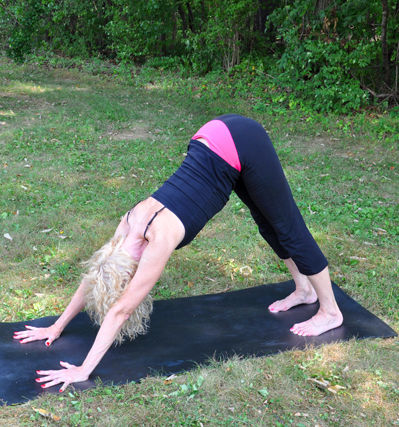
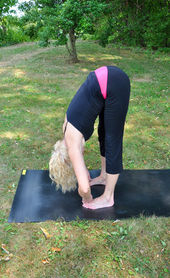
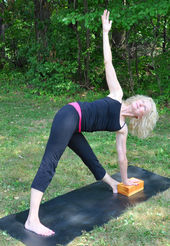
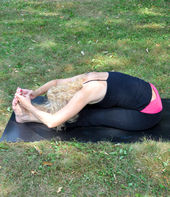
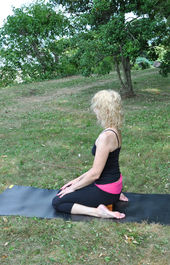
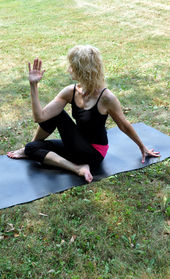
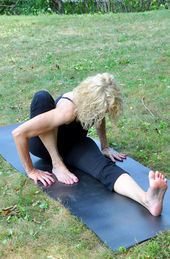
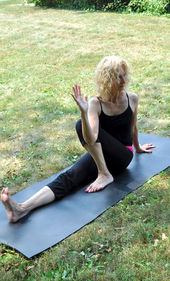
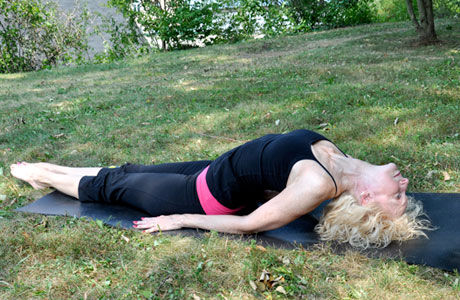
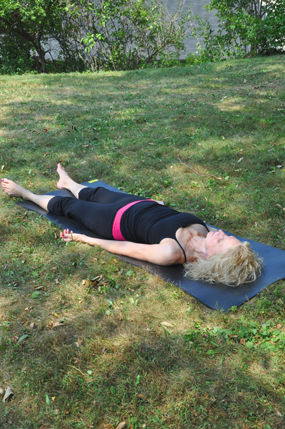



Reader Comments
to our Newsletter